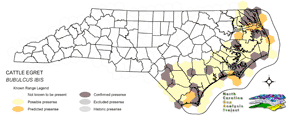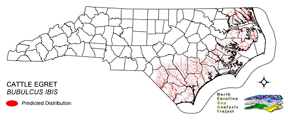
| Taxa: |
| Order: |
| Family: |
| Aves |
| Ciconiiformes |
| Ardeidae |
| NatureServe Global Rank: |
| NatureServe State (NC) Rank: |
| G5 |
| S4B,SZN |
| Federal Status: |
| NC State Status: |
| --- |
| --- |


| Land Unit |
| US Fish & Wildlife Service |
| US Forest Service |
| US National Park Service |
| US Department of Defense |
| NC State Parks |
| NC University System |
| NC Wildlife Res. Com. |
| NC Forest Service |
| NC Div. of Coastal Mgmt. |
| Local Governments |
| Non-Governmental Org. |
| Other Public Lands |
| Private Lands |
| GAP Status 1-2 |
| All Protected Lands |
| Statewide |
| Hectares |
| 36,926.19 |
| 3,011.40 |
| 17,933.40 |
| 6,741.00 |
| 3,881.16 |
| 1,737.63 |
| 14,697.72 |
| 1,752.93 |
| 2,900.43 |
| 45.99 |
| 6,088.95 |
| 359.91 |
| 462,624.75 |
| 66,139.74 |
| 95,306.49 |
| 558,701.46 |
| Acres |
| 91,246.58 |
| 7,441.33 |
| 44,314.39 |
| 16,657.37 |
| 9,590.55 |
| 4,293.78 |
| 36,318.85 |
| 4,331.58 |
| 7,167.12 |
| 113.64 |
| 15,046.12 |
| 889.36 |
| 1,143,170.43 |
| 163,434.82 |
| 235,507.42 |
| 1,380,581.11 |
| % of Dist. on |
| Prot. Lands |
| 38.7 % |
| 3.2 % |
| 18.2 % |
| 7.1 % |
| 4.1 % |
| 1.8 % |
| 15.4 % |
| 1.8 % |
| 3.0 % |
| 6.4 % |
| 6.4 % |
| < 0.1 % |
| 0.1 % |
| 69.4 % |
| ----- |
| ----- |
| % of Dist. on |
| All Lands |
| 6.6 % |
| 0.5 % |
| 3.2 % |
| 1.2 % |
| 0.7 % |
| 0.3 % |
| 2.6 % |
| 0.3 % |
| 0.5 % |
| < 0.1 % |
| 1.1 % |
| < 0.1 % |
| 82.8 % |
| 11.8 % |
| ----- |
| ----- |
|
Common but local on the coast and barrier islands (Fussell 1994); a rare visitor inland (Simpson 1992). Forages in a variety of open areas such as farms and highway edges. Most commonly feeds in dry fields on the insects flushed by livestock or farm equipment, but also in flooded fields and marshes (Kaufman 1996). Breeds in salt and freshwater habitats and on islands (Palmer 1962). In North Carolina, may be restricted to the immediate area of breeding colonies and agricultural areas, especially where there is livestock or where fields are being plowed (Fussell 1994). Nests in colonies of thousand, and in association with other herons and ibises (Palmer 1962). Will compete for nests and steal nesting material from other species. Nest is built up to 65 feet above the ground in a tree or shrub (Ehrlich et al. 1988). NATURE SERVE GLOBAL HABITAT COMMENTS: Wet pastureland and marshes, fresh water and brackish situations, dry fields, agricultural areas (especially irrigated ones), garbage dumps. In West Indies, roosts at night in mangrove swamps or on mangrove islands (Raffaele 1983). Nests in trees on islands in lakes; along watercourses; in swamps; on mangrove cays; near marshes. Usually nests with other herons or in single species colonies. |
| Code | Name | Description | NC Natural Heritage Program Equivalent |
| 3 | Tidal Marsh | Fresh and brackish tidal marshes, including cord grass, wild rice, sawgrass and needlerush alliances. | Brackish Marsh, Interdune pond, Maritime wet grassland |
| 124 | Maritime Scrubs and Tidal Shrublands | Coastal shrubs including wax-myrtle, swamp rose, alder, yaupon, and greenbriar. | Maritime Shrubs, Salt Shrub |
| 375 | Hypersaline coastal salt flats | Tidal flats within salt marshes, including saltmeadow cordgrass or sea-purslane dominated alliances. | Salt Marsh |
| 372 | Interdune Herbaceous Wetlands | Dune swales with permanently flooded to intermittently exposed hydrology. Species composition depends on salinity and can include cut grass, spike-rush, mosquito fern, and hornwort. | Interdune Pond, Maritime Wet Grasslands |
| 371 | Maritime Grasslands | Dune grass community consisting of sea oats and beach grasses. | Dune grass, Maritime dry grassland |
| 75 | Tidal Swamp Forest | Swamp tupelo dominated forest with or without black tupelo and/or cypress trees. Restricted to the tidal zones in the coastal plain. May have inclusions of coastal red cedar woodlands. | Tidal cypress - gum swamp |
| 121 | Maritime Pinelands | Loblolly forests and woodlands of the outer coastal plain. | Estuarine Fringe Loblolly Pine Forest |
| 17 | Maritime Forests and Hammocks | Maritime forests and woodlands dominated by live or sand laurel oak. Estuarine Fringe forests dominated by loblolly pine. | Coastal Fringe Evergreen Forest, Maritime Deciduous Forest, Maritime Deciduous Forest |
| 126 | Interdune Wooded Depression Swamp | Includes swamps dominated by sweetbay and swampbay or dogwood dominated forests. | Maritime Shrub Swamp, Maritime Swamp Forest |
| 380 | Coastal Plain Fresh Water Emergent | Emergent vegetation in fresh water seepage bogs, ponds and riverbeds of the coastal plain. Includes alliances dominated by sedges, eelgrass, as well as cane found in unforested cane-brakes. | Small Depression Pond, Sandhill Seep, Floodplain Pool, Unforested Floodplain Canebrake, Riverscour Prairies, Vernal Pools |
| 173 | Coastal Plain Riverbank Shrubs | Shrub dominated riverbanks, commonly dominated by willows and/or alders. | Sand and Mud Bar |
| 50 | Coastal Plain Mixed Bottomland Forests | Includes forests dominated by a variety of hardwood species, including sweetgum, cottonwood, red maple. | Coastal Plain Bottomland Hardwood (in part), Coastal Plain Levee Forest |
| 49 | Coastal Plain Oak Bottomland Forest | Bottomland forests dominated by deciduous oak alliances. Oaks represented can include swamp chestnut, cherrybark, willow, and/or overcup oak. Inclusions of loblolly pine temporarily flooded forests occur in patches. Hydrology is temporarily to seasonally flooded. | Coastal Plain Bottomland Hardwoods (in part) blackwater subtype, brownwater subtype |
| 30 | Cypress-Gum Floodplain Forests | Swamps dominated by black or swamp tupelo with or without Taxodium. Seasonally to semi-permanently flooded hydrology. | Cypress-Gum Swamps |
| 78 | Pond-Cypress - Gum Swamps, Savannas and Lakeshores | Cypress dominated swamps and lakeshores. Can include bays dominated by pond cypress or shorelines of coastal plain lakes with a narrow band of cypress. | Non-riverine Swamp Forest, Natural Lakeshores (in part) |
| 385 | Oak Bottomland Forest and Swamp Forest | The swamp chestnut oak, cherrybark oak, shumard oak and sweetgum alliance is one representative. Other alliances are dominated by water, willow, and overcup oaks. Swamp forests can be dominated by sweetgum, red maple, and black gum being dominant. Loblolly can occur in combination with sweetgum and red maple, or with tulip poplar. Includes saturated and semi- to permanently flooded forests in the mountains. | Piedmont/Mountain Bottomland Forest, Piedmont/Mountain Swamp Forest |
| 205 | Agricultural Pasture/Hay and Natural Herbaceous | Farm fields used for pasture grass or hay production, as well as old fields dominated by native and exotic grasses. | No equivalent |
| 202 | Residential Urban | Includes vegetation interspersed in residential areas. Includes lawns, mixed species woodlots, and horticultural shrubs. Vegetation accounts for between 20 - 70% of the cover. | No equivalent |
| 8 | Open water | Open water without aquatic vegetation. | No equivalent |
|
Bock, C. E., and L. W. Lepthien. 1976. Population growth in the cattle egret. Auk 93:164-166.
Simpson MB Jr. 1992. Birds of the Blue Ridge Mountains. Chapel Hill and London: University of North Carolina Press. Siegfried, W.R. 1978. Habitat and the modern range expansion of the cattle egret. Wading Birds, National Audubon Society Research Report, No. 7. Fussell, J.O. III. 1994. A birderís guide to coastal North Carolina. Chapel Hill and London: The University of North Carolina Press. Kaufman K. 1996. Lives of North American Birds. Boston, New York: Houghton Mifflin Company. Palmer, R. S. (editor). 1962. Handbook of North American birds. Vol. 1. Loons through flamingos. Yale University Press, New Haven. 567 pp. Telfair, R.C. II. 1983. The cattle egret:a Texas focus and world view. Texas Agricultural Experiment Station. (College Station). Payne, R. B., and C. J. Risley. 1976. Systematics and evolutionary relationships among the herons (Ardeidae). Univ. Michigan Mus. Zool., Misc. Publ. No. 150. 115 pp. Harrison, H.H. 1979. A field guide to western birds' nests. Houghton Mifflin Company, Boston. 279 pp. Terres, J.K. 1980. The Audubon Society encyclopedia of North American birds. Alfred A. Knopf, New York. American Ornithologists' Union (AOU), Committee on Classification and Nomenclature. 1983. Check-list of North American Birds. Sixth Edition. American Ornithologists' Union, Allen Press, Inc., Lawrence, Kansas. Raffaele, H.A. 1983. A guide to the birds of Puerto Rico and the Virgin Islands. Fondo Educativo Interamericano, San Juan, Puerto Rico. 255 pp. Telfair, R. C. 1983. The cattle egret, a Texas focus and world view. Texas A & M Univ. Press. 144 pp. Shallenberger, R. J., editor. 1984. Hawaii's birds. Thirdedition. Hawaii Audubon Society, Honolulu. Pratt, H.D., P.L. Bruner, and D.G. Berrett. 1987. A field guide to the birds of Hawaii and the tropical Pacific. Princeton University Press, Princeton, New Jersey. 409 pp. + 45 plates. Ehrlich, P.R., D.S. Dobkin, and D. Wheye. 1988. The birder's handbook:a field guide to the natural history of North American birds. Simon and Shuster, Inc., New York. xxx + 785 pp. Root, T. 1988. Atlas of wintering North American birds:An analysis of Christmas Bird Count data. University of Chicago Press. 336 pp. Spendelow, J.A., and S.R. Patton. 1988. National atlas of coastal waterbird colonies in the contiguous United States:1976-1982. U.S. Fish and Wildlife Service, Biological Report 88(5). x + 326 pp. Stiles, F.G., and A.F. Skutch. 1989. A guide to the birds of Costa Rica. Comstock Publ. Associates, Cornell University Press, Ithaca, New York. 511 pp. Droege, S., and J.R. Sauer. 1990. North American Breeding Bird Survey, annual summary, 1989. U.S. Fish and Wildlife Service, Biological Report 90(8). 22 pp. |
For more information please contact them at:
NC-GAP Analysis Project
Dept. of Zoology, NCSU
Campus Box 7617
Raleigh, NC 27695-7617
(919) 513-2853
www.basic.ncsu.edu/ncgap